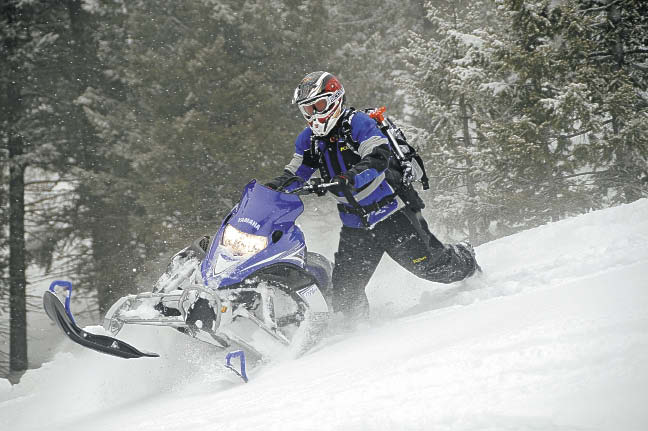 Just about everyone has heard the phrase, "The more things change, the more they stay the same."
Just about everyone has heard the phrase, "The more things change, the more they stay the same."
When it comes to the Yamaha Nytro MTX for 2011, we'd change that familiar catch phrase to "The more things stay the same, the more they change."
Just when it looked like the Nytro MTX was being rolled out this winter with few changes from the 2010 version, Yamaha unloaded a bombshell at Hay Days in September. We first alerted you to this bombshell just minutes after it was dropped in Sunrise Township, MN, site of Hay Days (http://www.snowest.com/snowmobile-news/display.cfm?ID=2520).
Indeed the announcement about the turbo and supercharger is exciting for Yamaha devotees and others who crave horsepower. That's why we've devoted an entire story to what to expect with the latest announcement and upgrade for the Nytro MTX.
Just remember, every great work-whether it be a painting, an excellent meal or even a great snowmobile ride-starts with some basic component. In the case of Yamaha's latest creation, it's the Nytro MTX.
Solid Components
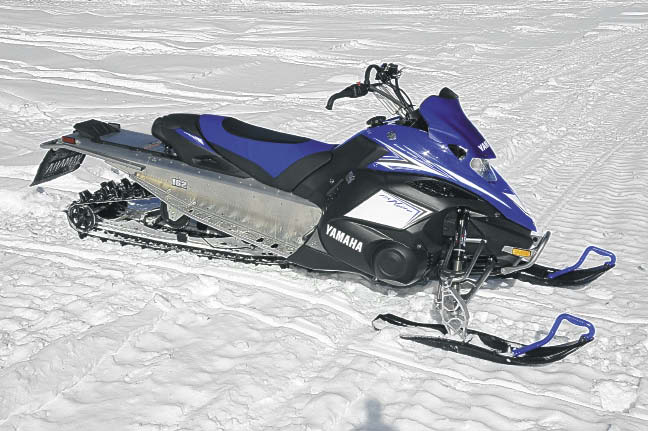 The Nytro MTX makes a great platform because of its solid stock components and features, which, granted, haven't changed from the 2010 model, but still make up a solid machine that hasn't experienced any hiccups since its creation.
The Nytro MTX makes a great platform because of its solid stock components and features, which, granted, haven't changed from the 2010 model, but still make up a solid machine that hasn't experienced any hiccups since its creation.
Yamaha's Wade West, the company's snowmobile marketing manager, admitted, "Pretty much everything from the 11-degree tunnel downward was new on the Nytro MTX SE 162 (and 153) last year, so we didn't make any changes aside from giving it a fresh new look in Yamaha black and red."
All sparkly and new or not, with all due respect to the Phazer MTX, the Nytro MTX represents the heart of Yamaha's mountain lineup. The company's mountain segment was trimmed by one model-the Apex MTX-for 2011, which leaves just the Phazer and Nytro versions of the MTX. As we mentioned in the March issue of SnoWest, it wasn't a total surprise that the Apex MTX is now a part of the Yamaha history books as a year ago you couldn't buy that model in Canada. To us, that foretold the demise of the Apex.
With the elimination of the Apex MTX, does that make the Nytro MTX Yamaha's "token" mountain sled? Being a token mountain sled isn't exactly the same as being the heart of the lineup. We tend to lean toward the heart of the mountain lineup option. Why? We don't think a company as big as Yamaha would toy with a portion of the industry-the mountain segment-that represents less than 25 percent of the market. Yamaha is keeping its name in the game because it obviously still wants a piece of the action. That's evidenced by a couple of things. First, it was West and other Yamaha officials who earlier this year pointed out that the mountain segment is the fastest-growing part of the snowmobile market. And second, why would Yamaha go to the effort of offering a turbo and supercharger if it didn't care about the mountains?
And if the company didn't continually have to face the pesky weight issue that dogs Yamaha's four-stroke mountain sleds, there would be even more excitement surrounding the MTX models.
Holding The Hammer
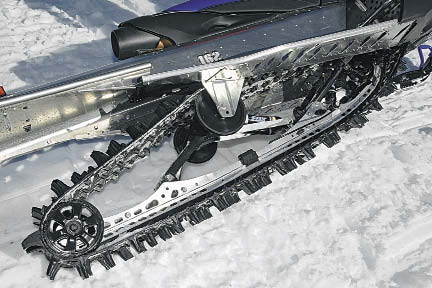 Admittedly, we've been one of those who have hammered the weight issue home. We make no apologies for wanting a sled that is light and won't wear us out during a day's ride. But we're willing to give credit where it's due.
Admittedly, we've been one of those who have hammered the weight issue home. We make no apologies for wanting a sled that is light and won't wear us out during a day's ride. But we're willing to give credit where it's due.
For one moment, let's not compare Yamaha's four-stroke mountain sleds to the lighter two-stroke models. It's not a really fair comparison, due mostly to the engine. But let's do compare the 2011 Nytro MTX to say, the RX-1 or any other Yamaha four-stroke from days past. The Nytro MTX is most definitely lighter.
Yamaha no longer publishes the weight of it snowmobiles. But we weighed our 2010 Nytro MTX when we got it right from the dealer last fall and its weight, full of oil and gas, was 608 lbs. Now compare that to the 2004 RX-1 Mountain, which tipped the scales at 582 lbs. dry. Add the weight of gas (roughly 66 lbs. for that machine) and you're up to 648 lbs.
Yamaha is definitely headed in the right direction, something the company proved when it introduced the 2010 Nytro MTX. The 2011 Nytro MTX 153, which again, is an identical twin to the 2010 model, is about 20 lbs. lighter than the 2009 Nytro. Who knows where Yamaha will tackle weight next and when it will happen? Right now, it's obvious the focus is on improving the power-to-weight by increasing the power, which stands at about 130 hp from the Genesis 3-cylinder four-stroke.
The very component that Yamaha is using as a base for increased horsepower is the same one that is the heaviest item on the Nytro MTX: the four-stroke engine. Since Yamaha has staked its sledding reputation and future on the four-stroke, it was logical for the company to make its move there.
A Pound Here, A Pound There
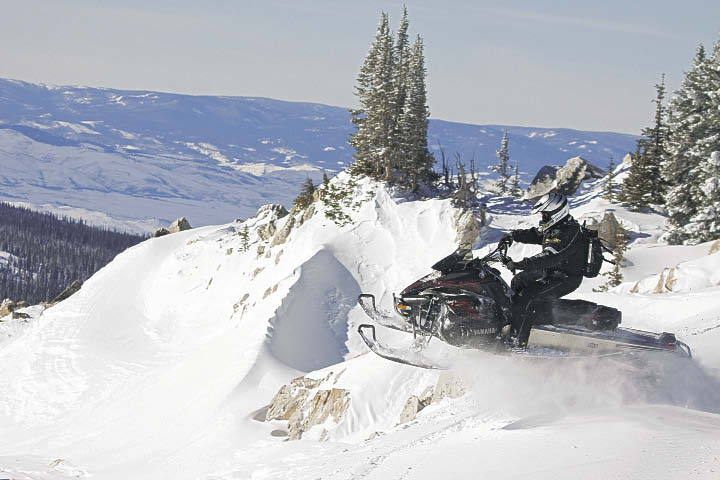 Yamaha has already shed pounds with the ProMountain Air rear suspension and single-ply Camoplast track and has creatively engineered its exhaust to exit the rear of the machine rather than near the engine, helping distribute the weight rather than even more weight being in the nose of the machine. Every little bit helps.
Yamaha has already shed pounds with the ProMountain Air rear suspension and single-ply Camoplast track and has creatively engineered its exhaust to exit the rear of the machine rather than near the engine, helping distribute the weight rather than even more weight being in the nose of the machine. Every little bit helps.
Weight is only part of the equation-albeit an important part-when it comes to snow mobility and how much rider input is required. Where the weight sits and how the sled handles is another part. Yamaha has improved in those areas, too. While sometimes the heaviness of the four-stroke engine can be tiring as you dive in and out of moguls on backcountry trails, the geometry of the Nytro MTX makes it fairly easy to hold the machine in a sidehill in powder. Interestingly enough, the Ntyro MTX, as do many mountain sleds, seems to respond to varying snow depths differently. That seems like a "duh" statement, but it can be pretty subtle at times. The 18-degree approach angle on the track goes a long way in helping "lift" the machine up on top of the snow, rather than plowing through it, an especially important feature considering the weight of a four-stroke engine.
SnoWest's Ryan Harris wrote last year in reporting on the Nytro MTX, "The sled really likes about two feet of powder on a firm base. Firm snow conditions will bring out the weight factor more than riding it in powder, but the changes to the suspension still make it a better ride in all conditions." A season later, we still stand by that statement. Any snow depths on either side of that number changes the handling characteristics of the Nytro as well as the amount of rider input needed. Deeper snow and you'll find yourself feeling the weight of the machine more.
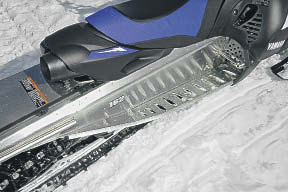 The rider can also adjust the handling and ride of the sled by learning how to fine tune the ProMountain rear suspension, which is highly tunable. After a slight learning curve on how to adjust the Fox Float shocks, you can set up the suspension for any kind of conditions you might encounter in the backcountry from rutted-out trails to powder riding. The adjustments are made with a dual gauge air pump. (See sidebar.)
The rider can also adjust the handling and ride of the sled by learning how to fine tune the ProMountain rear suspension, which is highly tunable. After a slight learning curve on how to adjust the Fox Float shocks, you can set up the suspension for any kind of conditions you might encounter in the backcountry from rutted-out trails to powder riding. The adjustments are made with a dual gauge air pump. (See sidebar.)
One of the shining attributes of the Nytro MTX, and Yamaha sleds for that matter, is reliability. Name the last time you heard about a major mechanical issue on a Yamaha mountain sled. There's something to be said for being able to count on your sled running perfectly every weekend of the winter.
So while the Nytro MTX may look the same inside and out, oddly enough, things have changed in a big way for the heart of Yamaha's mountain lineup.
Adjusting Nytro MTX Fox Float Shocks
Here's a crash course in how to adjust the Fox Floats on the Nytro MTX ProMountain rear suspension. You'll need a Fox Float Dual Gauge Air Pump. You have to have the dual gauge version because the front gauge has a 0 to 300 psi range for the rear shock and the back gauge has a 0 to 90 psi range for the front and center shocks.
Put the rider on the sled.
Push down on the rear bumper and release. This helps take the stiction out of the shocks. The suspension will rise to a neutral point.
Measure from the center of the rear suspension bolt to the top of the track belt.
Pull up on the back of the sled and let the suspension settle to its neutral point and measure from the same points again.
Add those two numbers together and divide by two. Adjust the air pressure until the number equals 247mm plus/minus 7mm.
Once you have the rear sag set, you can hit the snow. You can also adjust the air pressure on the snow while out riding. However, adjust the air pressure 5 lbs. at a time. Set the air pressure, test and readjust if necessary. When adjusting the rear suspension, start with the rear shock (Fox Float 2 XV) first and then move to the center shock (Fox Float 2).